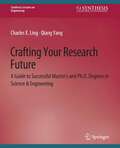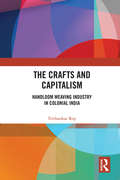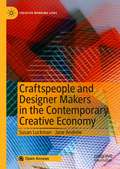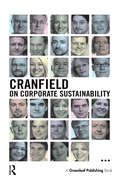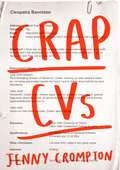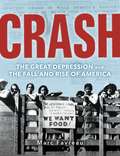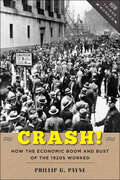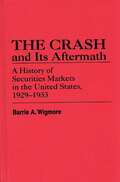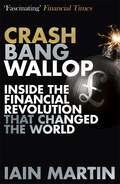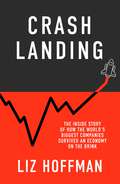- Table View
- List View
Crafting Your Edge for Today's Job Market: Using the BE-EDGE Method for Consulting Cases and Capstone Projects
by Julia IvyAre you looking to cut through the crowd of graduate job-seekers? To craft your edge in the saturated job market? Then you need the BE-EDGE Method. The BE-EDGE Method provides a step-by-step guide that connects job seekers to target employers through a process of case consulting. It creates an opportunity for the new or established professional to carve out their own space in an industry of choice, by establishing a relationship of trust with and proving their value to an industry insider. The method shows readers how to: Elucidate their professional CORE, strategically identifying a space in the market that will best fit their multidimensional profile and selecting a case to work on; Develop TRUST with an industry insider on the basis of deep understanding and storytelling--as an industry researcher, company biographer, and case writer; Generate VALUE for a company by making a concrete contribution and offering action-based solutions in the form of a consulting case report; and Excite insiders with the candidate's fit for a company and their potential to add value in the industry. These steps allow the BE-EDGE Method to help young graduates to enhance their employability, as well as helping life-long learners to redefine and craft their own space in the market when looking to change careers. Including testimonials from students of this method, this book is unmissable for anyone looking to create their own space in industry.
Crafting Your Research Future: A Guide to Successful Master's and Ph.D. Degrees in Science & Engineering (Synthesis Lectures on Engineering)
by Charles Ling Qiang YangWhat is it like to be a researcher or a scientist? For young people, including graduate students and junior faculty members in universities, how can they identify good ideas for research? How do they conduct solid research to verify and realize their new ideas? How can they formulate their ideas and research results into high-quality articles, and publish them in highly competitive journals and conferences? What are effective ways to supervise graduate students so that they can establish themselves quickly in their research careers? In this book, Ling and Yang answer these questions in a step-by-step manner with specific and concrete examples from their first-hand research experience. Table of Contents: Acknowledgments / Preface / Basics of Research / Goals of Ph.D. Research / Getting Started: Finding New Ideas and Organizing Your Plans / Conducting Solid Research / Writing and Publishing Papers / Misconceptions and Tips for Paper Writing / Writing and Defending a Ph.D. Thesis / Life After Ph.D. / Summary / References / Author Biographies
The Crafts and Capitalism: Handloom Weaving Industry in Colonial India
by Tirthankar RoyThis book presents a comprehensive history of handloom weaving industry in India to challenge and revise the view that competition from machine-produced textiles destroyed the country’s handicrafts as claimed by historians until recently. It shows that skill-intensive handmade textiles survived the competition on a large scale, and that handmade goods and high-quality manual labour played a positive role in the making of modern India. Rich in archival material, The Crafts and Capitalism explores themes such as the historiography of craft technologies; statistical work on nineteenth-century cotton cloth production trends; narratives of merchants, the social leaders, the factory-owners; tools and techniques; and, shift from handloom to power loom. The book argues that changes in the handloom industry were central to the consolidation of new forms of capitalism in India. An important intervention in Indian economic history, this book will be useful to scholars and researchers of Indian history, economic history, colonial history, modern history, political history, labour history and political economy. It will also interest nongovernmental organizations, textile historians, and design specialists.
The Crafts and Capitalism: Handloom Weaving Industry in Colonial India
by Tirthankar RoyThis book presents a comprehensive history of handloom weaving industry in India to challenge and revise the view that competition from machine-produced textiles destroyed the country’s handicrafts as claimed by historians until recently. It shows that skill-intensive handmade textiles survived the competition on a large scale, and that handmade goods and high-quality manual labour played a positive role in the making of modern India. Rich in archival material, The Crafts and Capitalism explores themes such as the historiography of craft technologies; statistical work on nineteenth-century cotton cloth production trends; narratives of merchants, the social leaders, the factory-owners; tools and techniques; and, shift from handloom to power loom. The book argues that changes in the handloom industry were central to the consolidation of new forms of capitalism in India. An important intervention in Indian economic history, this book will be useful to scholars and researchers of Indian history, economic history, colonial history, modern history, political history, labour history and political economy. It will also interest nongovernmental organizations, textile historians, and design specialists.
Craftspeople and Designer Makers in the Contemporary Creative Economy (Creative Working Lives)
by Susan Luckman Jane AndrewThis open access book explores the experience of working as a craftsperson or designer maker in the contemporary creative economy. The authors utilise evidence from the only major empirical study to explore the skills required and the challenges facing contemporary makers in an increasingly crowded marketplace. Drawing upon 180 interviews with peak organisations, established and emerging makers, and four years of fieldwork across Australia, this book offers a unique insight into the motivations informing those who seek to make an income from their craft or designer maker practice, as well as the challenges and opportunities facing them as they do so at this time of renewed interest internationally in the artisanal and handmade. Offering a rich and deep collection of real-life experiences, this book is aimed both at an academic and practitioner audience.
Cranfield on Corporate Sustainability
by David GraysonBusiness schools have a special contribution to make in developing globally responsible, critical and independent-thinking future leaders and managers. In fact, the Cranfield School of Management acknowledges this as one of its important responsibilities. Its core ideology is to transform the practice of learning and create leaders who action their knowledge and become stewards of the common good. Such thinking forms the basis of this book and its theme of developing responsible and ethical leaders for next-generation enterprises. These leaders will be passionate, purposeful and responsible; their primary aim will be to make a difference in the lives of people and create sustainable value premised on sound ethical values. This book aims to provide a roadmap both for business students – the leaders of tomorrow – and for existing and engaged leaders who need support, coaching and counselling to address the challenges of the sustainability agenda. With contributions from more than thirty Cranfield faculty and associates across multiple management disciplines, the book emphasizes the need for cross-disciplinarity when confronting sustainability dilemmas. Many corporate responsibility practitioners find themselves isolated from core business issues. Conversely, many managers in traditional departments have little or no knowledge of what sustainability and corporate responsibility means to their day-to-day role. Today, there is an urgent need for learning, for conversation and for sustainability to become embedded throughout an organization's DNA. Cranfield strives to prepare its students for a work milieu that is increasingly complex, diverse, technologically interconnected, socially networked and where economic and political power shifts see emerging-market economies assuming significant global prominence. This makes for exciting challenges but also requires new mind-sets for the next generation of business men and women. Corporate responsibility, and the tough ethical and governance choices managers have to grapple with, where there are no easy answers, means that business education must embrace the stakeholder model. Leaders need to be able to negotiate their way with confidence around multiple perspectives and conflicting and common interests of stakeholders such as employees and managers, shareholders, trade unions, suppliers and civil society organisations. Business schools need to generate understanding of and sensitivity to this new and changing world of work. Today, the challenge for business schools and business itself is to establish a new maxim: "the business of business is sustainable business". Cranfield on Corporate Sustainability is designed to stimulate debate about what sustainable development means for business and, therefore, on what business schools across the globe should research, teach and advise. This unique book is a manifesto for a new holistic, embedded approach to corporate sustainability management education.
Cranfield on Corporate Sustainability
by David GraysonBusiness schools have a special contribution to make in developing globally responsible, critical and independent-thinking future leaders and managers. In fact, the Cranfield School of Management acknowledges this as one of its important responsibilities. Its core ideology is to transform the practice of learning and create leaders who action their knowledge and become stewards of the common good. Such thinking forms the basis of this book and its theme of developing responsible and ethical leaders for next-generation enterprises. These leaders will be passionate, purposeful and responsible; their primary aim will be to make a difference in the lives of people and create sustainable value premised on sound ethical values. This book aims to provide a roadmap both for business students – the leaders of tomorrow – and for existing and engaged leaders who need support, coaching and counselling to address the challenges of the sustainability agenda. With contributions from more than thirty Cranfield faculty and associates across multiple management disciplines, the book emphasizes the need for cross-disciplinarity when confronting sustainability dilemmas. Many corporate responsibility practitioners find themselves isolated from core business issues. Conversely, many managers in traditional departments have little or no knowledge of what sustainability and corporate responsibility means to their day-to-day role. Today, there is an urgent need for learning, for conversation and for sustainability to become embedded throughout an organization's DNA. Cranfield strives to prepare its students for a work milieu that is increasingly complex, diverse, technologically interconnected, socially networked and where economic and political power shifts see emerging-market economies assuming significant global prominence. This makes for exciting challenges but also requires new mind-sets for the next generation of business men and women. Corporate responsibility, and the tough ethical and governance choices managers have to grapple with, where there are no easy answers, means that business education must embrace the stakeholder model. Leaders need to be able to negotiate their way with confidence around multiple perspectives and conflicting and common interests of stakeholders such as employees and managers, shareholders, trade unions, suppliers and civil society organisations. Business schools need to generate understanding of and sensitivity to this new and changing world of work. Today, the challenge for business schools and business itself is to establish a new maxim: "the business of business is sustainable business". Cranfield on Corporate Sustainability is designed to stimulate debate about what sustainable development means for business and, therefore, on what business schools across the globe should research, teach and advise. This unique book is a manifesto for a new holistic, embedded approach to corporate sustainability management education.
Crap CVs
by Jenny CromptonApplication for EmploymentI refer to the recent death of the Technical Manager at your company and hereby apply for the replacement of the deceased manager.Each time I apply for a job, I get a reply that there is no vacancy but in this case I have caught you red-handed and you have no excuse because I even attended the funeral to be sure that he was truly dead and buried before applying.Attached to my letter is a copy of my CV and his death certificate.Crap CVs is a hilarious compilation of the worst job applications imaginable, including overly-honest cover letters, embarrassing typos, mortifying personal revelations, awkward interview questions, misplaced self-confidence, self-aggrandizing gibberish, blatant truth-twisting and, of course, outright lies.
Crash: The Great Depression and the Fall and Rise of America
by Marc FavreauThe incredible true story of how real people weathered one of the most turbulent periods in American history—the Great Depression—and emerged triumphant. From the sweeping consequences of the stock market crash to the riveting stories of individuals and communities caught up in a real American dystopia, discover how the country we live in today was built in response to a time when people from all walks of life fell victim to poverty, insecurity, and fear. Meet fascinating historical characters like Herbert Hoover, Franklin Delano and Eleanor Roosevelt, Frances Perkins, Dorothea Lange, Walter White, and Mary McLeod Bethune. See what life was like for regular Americans as the country went from the highs of the Roaring Twenties to the lows of the Great Depression, before bouncing back again during World War II. Explore pivotal scenes such as the creation of the New Deal, life in the Dust Bowl, the sit-down strikes in Michigan, the Scottsboro case, and the rise of Father Coughlin. Packed with photographs and firsthand accounts, and written with a keen understanding of the upheaval of the 1930s, Crash shares the incredible story of how America survived—and, ultimately, thrived.
Crash!: How the Economic Boom and Bust of the 1920s Worked (How Things Worked)
by Phillip G. PayneSpeculation�an economic reality for centuries�is a hallmark of the modern U.S. economy. But how does speculation work? Is it really caused, as some insist, by popular delusions and the madness of crowds, or do failed regulations play a greater part? And why is it that investors never seem to learn the lessons of past speculative bubbles? Crash! explores these questions by examining the rise and fall of the American economy in the 1920s.Phillip G. Payne frames the story of the 1929 stock market crash within the booming New Era economy of the 1920s and the bust of the Great Depression. Taking into account the emotional drivers of the consumer market, he offers a clear, concise explanation of speculation's complex role in creating one of the greatest financial panics in U. S. history.Crash! explains how postWorld War I changes in the global financial markets transformed the world economy, examines the role of boosters and politicians in promoting speculation, and describes in detail the disastrous aftermath of the 1929 panic. Payne's book will help students recognize the telltale signs of bubbles and busts, so that they may become savvier consumers and investors.
Crash and Beyond: Causes and Consequences of the Global Financial Crisis
by Andrew FarlowIn 2008, the world was plunged into a financial and economic crash. This book explores the roots of the crash, including the build-up of global economic imbalances, the explosion in the use of novel financial instruments, the mismanagement of risk, and the specific roles played by housing and debt. It reviews the evidence that on the eve of the crash all was not well and that many political and finance industry leaders ignored the dangers. The key events of the crash are described, and the main amplification mechanisms explained. An economics lens is used to dissect the bank rescue, paying particular attention to the hidden ways in which it worked, who will ultimately bear the costs, and to what degree new risks were created. The book evaluates the fiscal and monetary policies used to rescue economies, efforts to tackle unemployment, proposals for dealing with collapsing housing markets, austerity and the battles over long-term sovereign debt, the Eurozone crash, and the risks of future economic instability. It reviews reform-of mortgage markets, monetary policy, and banking-designed to make such disasters less likely in future. Written before, during, and in the years immediately after the crash, it is an engaging chronicle and comprehensive analysis of the events and thinking of these years. The book's arguments take on added authority given that the author had identified, and called attention to, key features of the crash before it happened.
The Crash and Its Aftermath: A History of Securities Markets in the United States, 1929-1933 (Contributions in Economics and Economic History)
by Barrie A. WigmoreThe Crash and Its Aftermath is an excellent work of reference on the Great Contraction. It will be useful both to people with only a passing curiosity about the Crash and to those for whom the Great Depression is a major scholarly concern. Business History From now on any serious student of the Depression will be obliged to consult this work for a sense of securities price movements, investor attitudes, and relevant contemporary sources. Journal of Economic HistoryThis is the first book to focus on the broader structural changes which took place in the financial industry over the full period of decline from the Stock Market Crash in 1929 to the end of President Franklin D. Roosevelt's One Hundred Days in 1933. The basis for many of Wigmore's comments is an analysis of 142 leading companies whose stocks constituted approximately 77 percent of the market value of all New York Stock Exchange stocks. Wigmore also examines the various bond markets and relates the money market to the bond market, monetary policy, business conditions, and the problems of the banking system. Treating each year from 1929 to 1933 separately, Wigmore shows the interrelation between the stock, bond, and money markets and events in politics, the economy, international trade and finance, and monetary policy. The Statistical Appendix of 41 tables consolidates financial statistics which have hitherto been widely dispersed, permitting in-depth study.
Crash Bang Wallop: The Inside Story of London’s Big Bang and a Financial Revolution that Changed the World
by Iain MartinPublished to mark the 30th anniversary of the financial revolution known as 'Big Bang', Crash Bang Wallop will tell the gripping story of how the changes introduced in the 1980s in the City of London transformed our world.Attitudes to money and the way we measure value and status were completely reshaped by Big Bang, and it had an extraordinary impact on politics, on style, on technology, on the class system, on questions of public ownership, and on the geography of London. Perhaps more than anything, Big Bang revolutionised the international markets, as the capital became a testing ground for financial globalisation, with huge repercussions for the global economy. The definitive insider's account of this critically important moment in modern history, Crash Bang Wallop will also explore what's next for global finance as it gets ready to undergo yet another revolution. 'Iain Martin tells it brilliantly, mixing fury-inducing narrative with an acute eye for the broader conclusion.' Observer
The Crash Course: The Unsustainable Future of Our Economy, Energy, and Environment
by Chris MartensonThe next twenty years will be completely unlike the last twenty years. The world is in economic crisis, and there are no easy fixes to our predicament. Unsustainable trends in the economy, energy, and the environment have finally caught up with us and are converging on a very narrow window of time—the "Twenty-Teens." The Crash Course presents our predicament and illuminates the path ahead, so you can face the coming disruptions and thrive--without fearing the future or retreating into denial. In this book you will find solid facts and grounded reasoning presented in a calm, positive, non-partisan manner. Our money system places impossible demands upon a finite world. Exponentially rising levels of debt, based on assumptions of future economic growth to fund repayment, will shudder to a halt and then reverse. Unfortunately, our financial system does not operate in reverse. The consequences of massive deleveraging will be severe. Oil is essential for economic growth. The reality of dwindling oil supplies is now internationally recognized, yet virtually no developed nations have a Plan B. The economic risks to individuals, companies, and countries are varied and enormous. Best-case, living standards will drop steadily worldwide. Worst-case, systemic financial crises will toss the world into jarring chaos. This book is written for those who are motivated to learn about the root causes of our predicaments, protect themselves and their families, mitigate risks as much as possible, and control what effects they can. With challenge comes opportunity, and The Crash Course offers a positive vision for how to reshape our lives to be more balanced, resilient, and sustainable.
The Crash Course: The Unsustainable Future of Our Economy, Energy, and Environment
by Chris MartensonThe next twenty years will be completely unlike the last twenty years. The world is in economic crisis, and there are no easy fixes to our predicament. Unsustainable trends in the economy, energy, and the environment have finally caught up with us and are converging on a very narrow window of time—the "Twenty-Teens." The Crash Course presents our predicament and illuminates the path ahead, so you can face the coming disruptions and thrive--without fearing the future or retreating into denial. In this book you will find solid facts and grounded reasoning presented in a calm, positive, non-partisan manner. Our money system places impossible demands upon a finite world. Exponentially rising levels of debt, based on assumptions of future economic growth to fund repayment, will shudder to a halt and then reverse. Unfortunately, our financial system does not operate in reverse. The consequences of massive deleveraging will be severe. Oil is essential for economic growth. The reality of dwindling oil supplies is now internationally recognized, yet virtually no developed nations have a Plan B. The economic risks to individuals, companies, and countries are varied and enormous. Best-case, living standards will drop steadily worldwide. Worst-case, systemic financial crises will toss the world into jarring chaos. This book is written for those who are motivated to learn about the root causes of our predicaments, protect themselves and their families, mitigate risks as much as possible, and control what effects they can. With challenge comes opportunity, and The Crash Course offers a positive vision for how to reshape our lives to be more balanced, resilient, and sustainable.
The Crash Course: An Honest Approach to Facing the Future of Our Economy, Energy, and Environment
by Chris MartensonDiscover how and why the world’s crises are interconnected and what you can do to prepare for the next one The world is experiencing a series of crises. In The Crash Course: An Honest Approach to Facing the Future of Our Economy, Energy, and Environment, Revised Edition, veteran executive and strategist Chris Martenson delivers an incisive and eye-opening exploration that explains why the reader needs to understand that it is the interconnectedness of the various crises that matters most. From energy shortages to climate instability, financial crises, supply chain disruptions, pandemics, war, and crop failures, you’ll discover the common factor that is driving them all and how to adapt to volatile new realities and safeguard your own personal wealth, health, and community. In the book, you’ll find effective solutions for living with unpredictability and change, as well as: A workable framework for understanding the “how” and “why” of dramatic societal, environmental, and economic transformation A rich set of solutions, complete with examples, you can use to draw inspiration and motivation to act in your own life An expansive amount of new material, fully updated since the last editionA transformative and thought-provoking strategic playbook for managing increasingly unexpected events, crises, and revolutions, The Crash Course, Revised Edition is an essential resource for anyone concerned about their retirement savings, the world’s environment, as well as anyone hoping to become more independent and self-reliant.
The Crash Course: An Honest Approach to Facing the Future of Our Economy, Energy, and Environment
by Chris MartensonDiscover how and why the world’s crises are interconnected and what you can do to prepare for the next one The world is experiencing a series of crises. In The Crash Course: An Honest Approach to Facing the Future of Our Economy, Energy, and Environment, Revised Edition, veteran executive and strategist Chris Martenson delivers an incisive and eye-opening exploration that explains why the reader needs to understand that it is the interconnectedness of the various crises that matters most. From energy shortages to climate instability, financial crises, supply chain disruptions, pandemics, war, and crop failures, you’ll discover the common factor that is driving them all and how to adapt to volatile new realities and safeguard your own personal wealth, health, and community. In the book, you’ll find effective solutions for living with unpredictability and change, as well as: A workable framework for understanding the “how” and “why” of dramatic societal, environmental, and economic transformation A rich set of solutions, complete with examples, you can use to draw inspiration and motivation to act in your own life An expansive amount of new material, fully updated since the last editionA transformative and thought-provoking strategic playbook for managing increasingly unexpected events, crises, and revolutions, The Crash Course, Revised Edition is an essential resource for anyone concerned about their retirement savings, the world’s environment, as well as anyone hoping to become more independent and self-reliant.
Crash Course in Accounting and Financial Statement Analysis
by Matan Feldman Arkady LibmanSeamlessly bridging academic accounting with real-life applications, Crash Course in Accounting and Financial Statement Analysis, Second Edition is the perfect guide to a complete understanding of accounting and financial statement analysis for those with no prior accounting background and those who seek a refresher.
Crash Course in Accounting and Financial Statement Analysis
by Matan Feldman Arkady LibmanSeamlessly bridging academic accounting with real-life applications, Crash Course in Accounting and Financial Statement Analysis, Second Edition is the perfect guide to a complete understanding of accounting and financial statement analysis for those with no prior accounting background and those who seek a refresher.
A Crash Course on Crises: Macroeconomic Concepts for Run-Ups, Collapses, and Recoveries
by Markus K. Brunnermeier Ricardo ReisAn incisive overview of the macroeconomics of financial crises—essential reading for students and policy experts alikeWith alarming frequency, modern economies go through macro-financial crashes that arise from the financial sector and spread to the broader economy, inflicting deep and prolonged recessions. A Crash Course on Crises brings together the latest cutting-edge economic research to identify the seeds of these crashes, reveal their triggers and consequences, and explain what policymakers can do about them.Each of the book’s ten self-contained chapters introduces readers to a key economic force and provides case studies that illustrate how that force was dominant. Markus Brunnermeier and Ricardo Reis show how the run-up phase of a crisis often occurs in ways that are preventable but that may go unnoticed and discuss how debt contracts, banks, and a search for safety can act as triggers and amplifiers that drive the economy to crash. Brunnermeier and Reis then explain how monetary, fiscal, and exchange-rate policies can respond to crises and prevent them from becoming persistent.With case studies ranging from Chile in the 1970s to the COVID-19 pandemic, A Crash Course on Crises synthesizes a vast literature into ten simple, accessible ideas and illuminates these concepts using novel diagrams and a clear analytical framework.
Crash-Kurs für Verkaufsleiter: Vom Start weg auf der Gewinnerseite
by Helmut S. Durinkowitz"Crash-Kurs für Verkaufsleiter" vermittelt das komprimierte Know-how für den erfolgreichen Start im neuen Job: Unternehmen und Mitarbeiter richtig einschätzen, mit Zahlen und Planungsinstrumenten umgehen, Marketing- und Verkaufsaktionen koordinieren und das Verkaufsteam zu Höchstleistungen anspornen.
Crash-Kurs für Verkaufsleiter: Vom Start weg auf der Gewinnerseite
by Helmut S. Durinkowitz"Crash-Kurs für Verkaufsleiter" vermittelt das komprimierte Know-how für den erfolgreichen Start im neuen Job: Unternehmen und Mitarbeiter richtig einschätzen, mit Zahlen und Planungsinstrumenten umgehen, Marketing- und Verkaufsaktionen koordinieren und das Verkaufsteam zu Höchstleistungen anspornen. Neu in der 3. Auflage: wichtige Hinweise, welche Anforderungen und Möglichkeiten sich durch den Einsatz neuer (Kommunikations-)Technologien ergeben.
Crash-Kurs für Verkaufsleiter: Vom Start weg auf der Gewinnerseite
by Helmut S. DurinkowitzWer exzellent verkaufen kann, ist noch lange kein guter Verkaufsleiter. Denn eine Führungsposition konfrontiert Newcomer mit gewaltigen Herausforderungen. Helmut S. Durinkowitz, selbstständiger Unternehmensberater und Trainer mit langjähriger Führungserfahrung im Vertrieb, vermittelt in „Crashkurs für Verkaufsleiter“ das komprimierte Know-how für den erfolgreichen Start im neuen Job. Sie erfahren, wie Sie Unternehmen und Mitarbeiter richtig einschätzen, sich und Ihr Verkaufsteam organisieren, Ihre Mannschaft zu Höchstleistungen anspornen, aber auch wie es gelingt, Marketing- und Verkaufsaktionen sinnvoll zu koordinieren oder mit Zahlen und Planungsinstrumenten richtig umzugehen. Zudem erhalten Sie wichtige Tipps, wie Sie Ihr Zeitmanagement durch den Einsatz neuer Kommunikationstechnologien optimieren können. Der Crash-Kurs für den Einstieg zum Aufstieg – mit praktischen Beispielen, wertvollen Tipps und nützlichen Checklisten. Neu in der 4. Auflage: Wie die Neukundengewinnung noch besser gelingt.
Crash Landing: The Inside Story Of How The World's Biggest Companies Survived An Economy On The Brink
by Liz HoffmanIt was the ultimate test for CEOs, and almost none of them saw it coming.__________In early March 2020, with the Dow Jones flirting with 30,000, the world's biggest companies were riding an eleven-year economic high. By the end of the month, millions would be out of work, iconic firms were begging for bailouts, and countless small businesses were in freefall. Slick consulting teams and country-club connections were suddenly of little use: business leaders were fumbling in the dark, tossing out long-term strategy and making decisions on the fly-decisions, they hoped, that might just save them.In Crash Landing, award-winning business journalist Liz Hoffman shows how the pandemic set the economy on fire-but if you look closely, the tinder was already there.Based on astonishing access inside some of the world's biggest and most iconic companies, this is a gripping account of the most remarkable period in modern economic history, revealing how they battled against an economic catastrophe for which there was no playbook: among them, AirBnB's Brian Chesky, blindsided by a virus in the middle of a high-stakes effort to go public; American Airlines's Doug Parker, shuttling between K Street and the White House, determined to secure a multi-billion-dollar bailout; and Ford's Jim Hackett, as his assembly lines went from churning out cars to ventilators.Crash Landing reveals the fear, grit, and gambles of the pandemic economy, while probing its implications for the future of work, corporate leadership, and capitalism itself, asking: Will this remarkable time give rise to newfound resilience, or become just anothercostly mistake to be forgotten?__________A gripping account of the financial carnage of the pandemic, revealing the fear, grit, and gambles that drove the economy's winners and losers.
Crash-Management in Projekten: Vorbeugen, Erkennen, Analysieren und Überwinden von Konflikten und Krisen
by Manfred NoéDieses Buch zeigt, wie sich Konflikte und Krisen frühzeitig erkennen und analysieren lassen, Krisen überwunden werden und durch welche präventiven Maßnahmen Krisensituationen gar nicht erst entstehen oder ihre Eskalation vermieden wird.

